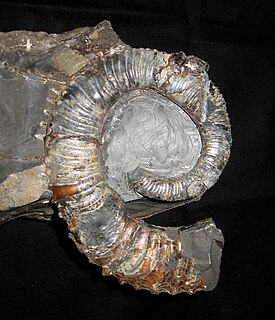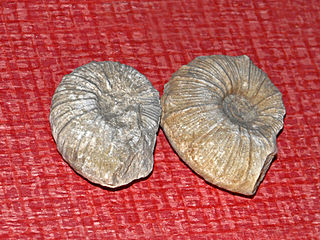
Australiceras is an extinct ammonite genus from the upper part of the Early Cretaceous, Aptian stage, included in the family Ancyloceratidae.
Algerites is middle Cretaceous (Cenomanian) anisoceratid ammonoid with a close-coiled adult shell in which the whorls at that stage are in close contact, after starting off with openly coiled whorls, and in which every rib has a pair of sharp ventral tubercles.
Bradfordia is a moderately involute to involute genus included in the ammonoid cephalopod family Oppeliidae, coiled so that the outer whorl encloses most, or much, of the previous, but with a small umbilicus exposing inner whorls. The shell is compressed, whorl height much greater than width, extending well out from the contact with the adjacent inner whorl. Outer flanks are finely ribbed and the rounded venter is smooth.
Oecotraustes is an extinct cephalopod genus included in the ammonid family Oppeliidae and named by Waagen in 1869. The genus lived during the Middle Jurassic.
Oecoptychius is an extinct genus of fossil ammonite cephalopods. The species lived during the Middle Jurassic.

Exiteloceras is an ammonite genus from the Late Cretaceous.
Tylonautilus is an extinct genus in the nautiloid order Nautilida from the Lower Carboniferous of Europe and Permian of Japan.

Peltoceras is an extinct ammonite genus from the aspidoceratid subfamily Peltoceratinae that lived during the later part of the Middle Jurassic.
Neoptychites is an extinct ammonoid cephalopod genus from the Turonian stage of the Upper Cretaceous, with a worldwide distribution.

Clymeniida is an order of ammonoid cephalopods from the Upper Devonian characterized by having an unusual dorsal siphuncle. They measured about 4 cm (1.6 in) in diameter and are restricted to Europe, North Africa, and possibly Australia.
Eoderoceras is an evolute, round whorled ammonite from the Lower Jurassic with an outer row of distinct spines, and in some, an inner row of tubercles, on either side; ribs only on the inner whorls.

Gymnites is a genus of ammonoid cephalopod from the Middle Triassic belonging to the ceratitid family Gymnitidae. These nektonic carnivores lived during the Triassic period, Anisian age.

Hauericeras is an ammonite genus from the Late Cretaceous that lived from the Coniacian to the late Maastrichtian, from about 90 to 66 mya. Fossils have been found in Europe, Russia, South Africa, Australia, India, Iraq, and in the United States.

Lytoceratinae is a subfamily of ammonoid cephalopods that make up part of the family Lytoceratidae.

Neocomites is a genus of ammonite from the Lower Cretaceous, Berriasian to Hauterivian, and type genus for the Neocomitidae.
Melchiorites is a desmoceratid ammonite genus included in the subfamily Puzosiinae. Member species are characterized by an essentially evolute shell in which the early whorls are smooth, with sinuous radial or oblique constrictions but in which later whorls have feeble intermediate ribs on the outer part of the sides and venter.

Monophyllites is an extinct cephalopod genus belonging to the family Ussuritidae that lived during the Triassic period, from Anisian to Ladinian age.

Harpoceras is an extinct genus of ammonite belonging to the family Hildoceratidae. These cephalopods existed in the Jurassic period, during the Toarcian age from the Falciferum zone to the Commune subzone of the Bifrons zone. They were fast-moving nektonic carnivores.

Holcodiscus is an extinct ammonite genus placed in the family Holcodiscidae. Species in this genus were fast-moving nektonic carnivores. The type species of the genus is Ammonites caillaudianus.
Radstockiceras is an extinct genus of lower Jurassic ammonite that lived from Oxynotum zone of upper Sinemurian to Raricostatum zone of lower Pliensbachian. Shells of these animals were oxycone and involute with umbilicus that took maximum of 12% of diameter in the case of outer whorls. On inner whorls, venter has been sharp, but then it became rounded. Faint ribs had falcoid shape, but sometimes, ribs could absent. Shells could have been large in their size. Suture has been very complex, similar to Oxynoticeras, but culmination at umbilical margin has been missing. Genus has been named after town of Radstock, in Somerset.










